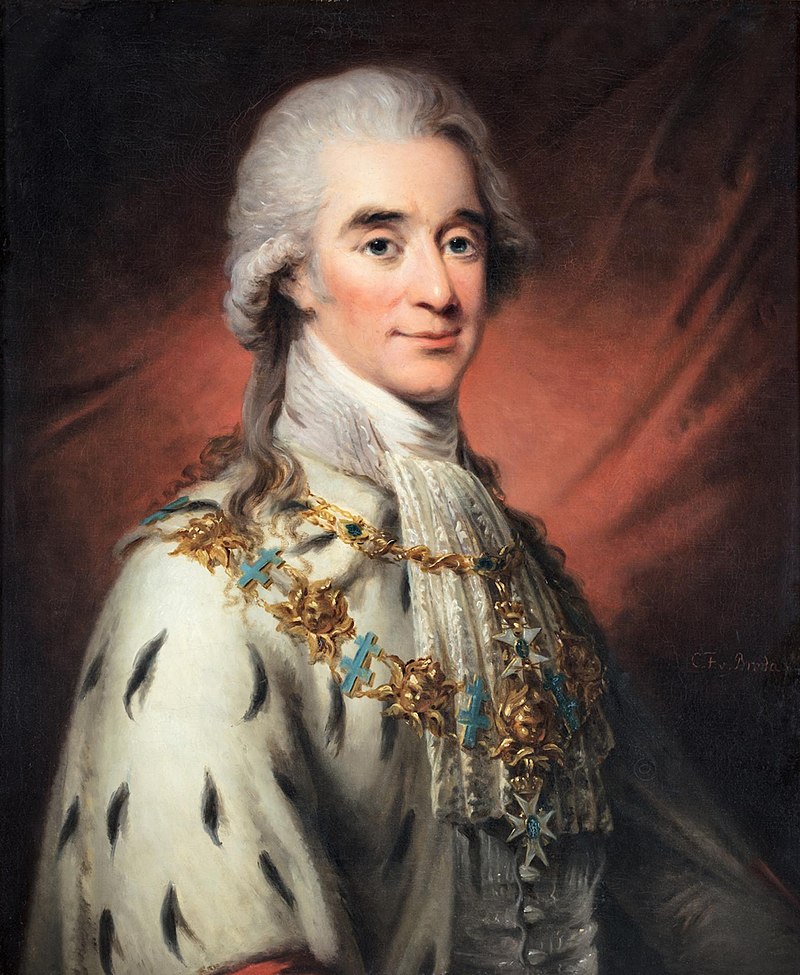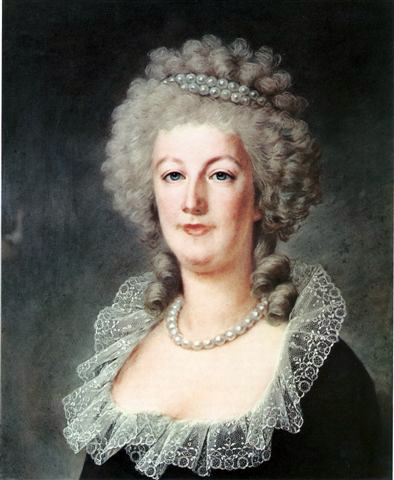by Scott Mehl
© Unofficial Royalty 2021
A prominent member of Swedish aristocracy, Count Axel von Fersen the Younger rose to the highest ranks of the Swedish royal court, serving as Marshal of the Realm for several years. He previously served as an aide-de-camp and interpreter to Rochambeau during the American Revolutionary War and became a close friend and favorite of Queen Marie Antoinette of France.

Axel von Fersen the Younger – source: Wikipedia
Axel von Fersen was born in Stockholm on September 4, 1755, the elder son of Field Marshal Axel von Fersen (the Elder) and Countess Hedvig Catharina De la Gardie. He had three siblings:
- Hedvig Eleonora (1753) – married Count Thure Klinckowström, had issue
- Eva Sophie (1757) – married Count Adolf Piper, had issue
- Fabian Reinhold (1762) – married Lovisa Piper, had issue
Axel was raised in one of the most prominent and influential Swedish aristocratic families. His mother had inherited Löfstad Castle and its large estates, and his father had extensive land holdings and was one of the largest shareholders in Sweden’s East India Company. In addition to Löfstad, the family owned Steninge Palace, Ljung Castle and Mälsåker Castle.

Queen Marie Antoinette of France. source: Wikipedia
Extensively educated, von Fersen became fluent in numerous languages that would serve him well in adulthood. He later continued his education in the military. In 1770, he began a grand tour, traveling throughout Europe and continuing his military training at several academies in Germany, France, and Italy. During this tour, he visited the royal courts of Sardinia, France, and the United Kingdom. While visiting France in 1774 von Fersen first met the future Queen Marie Antoinette.
Returning to Sweden the following year, he served in the Swedish military, but continued to visit France and began developing a friendship with the future Queen. In 1780, became an aide-de-camp to General Rochambeau during the American Revolutionary War, serving until the war’s end in 1783. Upon his return, King Gustav III of Sweden made him Captain of the Guard, hoping to have von Fersen by his side as he traveled throughout Europe to garner support for his plans to invade Denmark. The French king also gave von Fersen several honorary military appointments. As tensions began to rise in France, the Swedish King appointed von Fersen as his secret envoy to the French King and Queen, subverting the usual diplomatic channels and providing direct contact between the sovereigns.
Axel remained at court through the beginning of the French Revolution and was involved with the failed plans for the French Royal Family to escape, the unsuccessful Flight to Varennes. A warrant was issued for his arrest for his role in the plot, but he avoided capture. He traveled to Vienna to enlist the support of the Queen’s brother Holy Roman Emperor Leopold II resulting in the Declaration of Pillnitz which declared Prussia’s and the Holy Roman Empire’s support for the French King and monarchy.
His further efforts to protect and save the Queen and her family proved unsuccessful. He saw them for the last time in December 1791 but continued a correspondence with the Queen until her execution in October 1793. Having returned to Sweden, von Fersen later became one of the closest advisors to the new King Gustav IV Adolf, rising to the position of Earl Marshal, and by 1801, Marshal of the Realm.

A depiction of the murder of Axel von Fersen. source: Wikipedia
When King Gustav IV Adolf was deposed in 1809, the throne did not pass to his son and heir, but to his uncle, King Carl XIII who had no legitimate heirs. von Fersen led the support for the former King’s son, unsuccessfully. The new King adopted a Danish prince Carl August of Schleswig-Holstein-Sonderburg-Augustenburg to be his heir. However, the new Crown Prince died suddenly after falling from his horse in May 1810. Rumors quickly spread that he had been poisoned by the former King’s supporters – more specifically, at the hands of von Fersen.
On June 20, 1810, the public funeral was held for the Crown Prince. As Marshal of the Realm, von Fersen was one of the leaders of the procession through Stockholm. Despite the heavy presence of guards, several people broke free from the crowd in an attempt to get to von Fersen, while the guards mostly just looked on with disinterest. Fleeing the crowds, he tried to find safety in a nearby house but was quickly pursued and overtaken. He was dragged back into the street where he was quickly attacked and killed by the angry mob who blamed him for the Crown Prince’s death.

Ljungs Church. photo: Av Håkan Svensson – Eget arbete, CC BY 2.5, https://commons.wikimedia.org/w/index.php?curid=1455830
Several months later, von Fersen was cleared of having any part in the Crown Prince’s death, and received a state burial in Stockholm with full ceremonial honors. He is buried at the small church near his family’s Ljung Castle.
* * * * * * * * * *
This article is the intellectual property of Unofficial Royalty and is NOT TO BE COPIED, EDITED, OR POSTED IN ANY FORM ON ANOTHER WEBSITE under any circumstances. It is permissible to use a link that directs to Unofficial Royalty.
